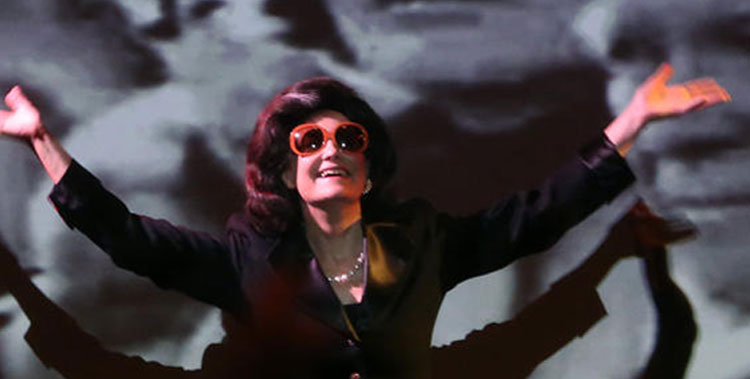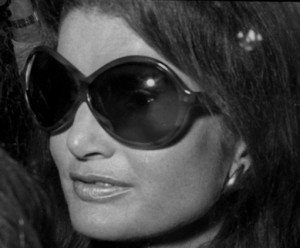 There are probably as many words written about the ‘Jackie look’ by now as there are actual images documenting it. A quick scan of just a few of these images taken over the roughly 40 years of her public life reveals quite a range: the young equestrienne, the insouciant debutante, the post-collegiate ‘career girl’ – and ‘inquiring photographer’ (as her employer, the Washington Star, dubbed her), the fashionable but dutiful young political wife, the glamourous (but always ‘appropriate’) First Lady, the First Widow morphed into international jet-setter, and finally the Onassis and post-Onassis years, which elevated her to a level of glamour and celebrity unprecedented in cultural history.
There are probably as many words written about the ‘Jackie look’ by now as there are actual images documenting it. A quick scan of just a few of these images taken over the roughly 40 years of her public life reveals quite a range: the young equestrienne, the insouciant debutante, the post-collegiate ‘career girl’ – and ‘inquiring photographer’ (as her employer, the Washington Star, dubbed her), the fashionable but dutiful young political wife, the glamourous (but always ‘appropriate’) First Lady, the First Widow morphed into international jet-setter, and finally the Onassis and post-Onassis years, which elevated her to a level of glamour and celebrity unprecedented in cultural history.
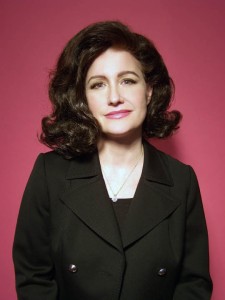 Just for the record, Karen Finley brought a variation that became something of a staple for Jackie between the mid- to late-1970s and the very early 1990s: big, but not exactly ‘bouffant’ hair, with a bit of wave and curl (call it ‘post-Kenneth’); de rigueur over-sized sunglasses, but these with squarish frames in red; longish tailored jacket or light overcoat, slightly regimental cut, double-breasted, over long flared trousers. Finley’s jacket was black with black satin lapels, a funereal touch appropriate to Finley’s themes. The pants were white – conceivably a nod to the Onassis years of Skorpios and Mediterranean pleasure ports not long behind her then (or perhaps to L.A.’s post-global warming permanent summer?). If the glamour seems tamped down, bear in mind these were years of fresh widowhood for Onassis – settling into a new private and professional life as an editor (Viking at first) and public-spirited New Yorker.
Just for the record, Karen Finley brought a variation that became something of a staple for Jackie between the mid- to late-1970s and the very early 1990s: big, but not exactly ‘bouffant’ hair, with a bit of wave and curl (call it ‘post-Kenneth’); de rigueur over-sized sunglasses, but these with squarish frames in red; longish tailored jacket or light overcoat, slightly regimental cut, double-breasted, over long flared trousers. Finley’s jacket was black with black satin lapels, a funereal touch appropriate to Finley’s themes. The pants were white – conceivably a nod to the Onassis years of Skorpios and Mediterranean pleasure ports not long behind her then (or perhaps to L.A.’s post-global warming permanent summer?). If the glamour seems tamped down, bear in mind these were years of fresh widowhood for Onassis – settling into a new private and professional life as an editor (Viking at first) and public-spirited New Yorker.
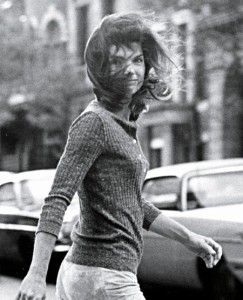 Having established the frame – a clear silhouette for her medium, Finley was free to move on to the real subject of her performance, which might be summed up as, the ‘trauma of the received gaze.’ Except that it was so much more than just that – there are multiple levels of trauma in operation here – which worked both for and against the coherence of the performance as a whole. Finley slammed it to the audience early in the performance. The ‘Jackie look(s)’ is not simply self-defined or adapted, but imposed by the context of circumstances, conventions, language (consistent with Broad guest curator and U.C. Riverside English professor, Jennifer Doyle’s “Tip of Her Tongue” theme), and the culture itself. In other words, the ‘Jackie looks’ were (and are) our own – nor would they necessarily be reciprocated or in any way ‘returned.’ The extent to which Jacqueline Onassis herself internalized this ‘look,’ this aesthetic self-definition, remains open to debate.
Having established the frame – a clear silhouette for her medium, Finley was free to move on to the real subject of her performance, which might be summed up as, the ‘trauma of the received gaze.’ Except that it was so much more than just that – there are multiple levels of trauma in operation here – which worked both for and against the coherence of the performance as a whole. Finley slammed it to the audience early in the performance. The ‘Jackie look(s)’ is not simply self-defined or adapted, but imposed by the context of circumstances, conventions, language (consistent with Broad guest curator and U.C. Riverside English professor, Jennifer Doyle’s “Tip of Her Tongue” theme), and the culture itself. In other words, the ‘Jackie looks’ were (and are) our own – nor would they necessarily be reciprocated or in any way ‘returned.’ The extent to which Jacqueline Onassis herself internalized this ‘look,’ this aesthetic self-definition, remains open to debate.
 But there is also a significant cultural (as well as political) rupture that predates this transitional Jackie – marked by her first widowhood: the assassination of President John F. Kennedy – a double trauma played out in public space. The assassination and its aftermath marked a watershed cultural moment – the culmination of an evolutionary stage of mass media and a new media consciousness. Finley homes in on both the iconic Zapruder 8-mm footage and its contemporary transmogrifications and (more hilariously) commodification. Not only are the horrific moments of carnage and panic continuously replayed; but the entire location is repurposed for un-self-consciously celebratory events and re-branded as if it were a new design house or cultural institution.
But there is also a significant cultural (as well as political) rupture that predates this transitional Jackie – marked by her first widowhood: the assassination of President John F. Kennedy – a double trauma played out in public space. The assassination and its aftermath marked a watershed cultural moment – the culmination of an evolutionary stage of mass media and a new media consciousness. Finley homes in on both the iconic Zapruder 8-mm footage and its contemporary transmogrifications and (more hilariously) commodification. Not only are the horrific moments of carnage and panic continuously replayed; but the entire location is repurposed for un-self-consciously celebratory events and re-branded as if it were a new design house or cultural institution.
 Finley presents her “Jackie” (we each have our own) as her own synthesis – a cocktail of Jackies to loosen mind and tongue across a far-ranging field: the trauma of the reenacted events, the trauma of repetition (we see her cavorting in front of the Warhol “Twenty Jackies” before making her entrance), and the compulsive viewing of trauma; the traumas of cultural appropriation, commodification, cannibalization (she makes mincemeat of eBay merchandising of Kennedy memorabilia and the Dealey Plaza Sixth Floor Museum) – the ‘organization’ of trauma (as she phrases it); the trauma of the gazes imposed upon her, the commodification of her own persona and celebrity; the trauma of sealing herself off from it; the trauma of communicating across the gulf of implied but mutually proscribed understandings.
Finley presents her “Jackie” (we each have our own) as her own synthesis – a cocktail of Jackies to loosen mind and tongue across a far-ranging field: the trauma of the reenacted events, the trauma of repetition (we see her cavorting in front of the Warhol “Twenty Jackies” before making her entrance), and the compulsive viewing of trauma; the traumas of cultural appropriation, commodification, cannibalization (she makes mincemeat of eBay merchandising of Kennedy memorabilia and the Dealey Plaza Sixth Floor Museum) – the ‘organization’ of trauma (as she phrases it); the trauma of the gazes imposed upon her, the commodification of her own persona and celebrity; the trauma of sealing herself off from it; the trauma of communicating across the gulf of implied but mutually proscribed understandings.
Finley does her own little dance of repetition over the events in Dallas, taking in slights large and small – from the red (as opposed to Texas-yellow) roses presented to her at Love Field, to the pestering about her blood-stained pink Chanel suit. Other potential slights to her ego are easily forgiven (as they were pretty much in her actual life). She ‘loves’ Marilyn – though Finley gives her love a Warhol-ironic gloss. At one point, Finley put down her notes (and Perrier) and actually started to dance to footage of the great disco star, Sylvester (“You Make Me Feel (Mighty Real)”), enlisting selected audience members to join her in a Studio 54 moment (reflecting the post-Onassis period of her life that really did take her to a still higher plateau of celebrity).
She might have brought the performance to a close right there – the Sylvester interlude might have worked as a coda. Certainly there was more ground to cover – Finley’s subject here is vast: cultural violence complicating and complicated by social and psychological violence. But drawing out a discussion that at various turns veered sharply into theoretical excursus while compressing it dramatically would challenge the most brilliant philosophers and playwrights/actors alike. Finley frequently turned to written notes in the waning minutes of a performance that threatened to become a lecture — stretching her audience’s patience to the breaking point. (Even her voice modulated from Jackie’s signature husky-whisper girls school voice to her own, to a kind of movie-trailer ‘in a world where…’ baritone goddess voice.) As always, Finley was at her best letting her ‘primal’ voice take center-stage. At one point, she takes a maternal defense of one of her cubs – defending Caroline Kennedy Schlossberg’s casual insertion of ‘you knows’ into interview responses – and builds it into a raging cultural indictment: the casual ‘you know’ swelling into “You – Know! You. No!”
There was another show or two here. (Maybe a couple of different lectures, too – I was beginning to half-expect a question-answer section by the performance’s end.) There’s a lot we don’t know here. That Onassis was to some extent restrained, even restricted behind those big black bubble glasses – by ‘the gaze’ – is pretty clear. It’s also clear that Onassis willfully and skillfully steered that gaze (however she may have been put off by its ‘re-marketing’ — e.g., by paparazzi like Ron Galella). She was thoroughly conscious of the image she was projecting and assiduously crafted and edited it from the time of Kennedy’s presidential campaign. Her obsessive control of ‘the narrative,’ from the “Camelot” White House she charged T. H. White with manufacturing, to her control over the JFK legacy, to her own post-Onassis transformations, practically created a new model of public relations.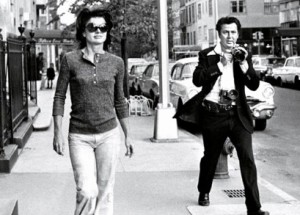
The timeline of famous Jackie portraits, news photos and snapshots that preceded Finley’s actual performance was an implicit acknowledgment of this power. Finley opens the performance against the newsreel of President Kennedy’s opening remarks at a press conference for his French state visit: “I am the man who accompanied Jacqueline Kennedy to Paris, and I’ve enjoyed it.” Only six months after Kennedy takes office, ‘Jackie’ is already as important as ‘Jack’ in this new media equation. It is the beginning of a new kind of fame and celebrity, and a portent of power couples to come, from Liz and Dick to Yoko and John to Hillary and Bill. Finley’s Jackie Look raises far more questions than it can possibly answer. If celebrity imposes its own kind of trauma, and we can assume all trauma has a dissociative power, we might ask whether celebrity can be viewed as an index of a still more profound cultural trauma.

